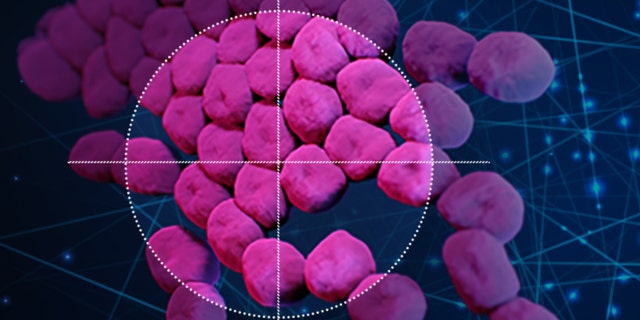Scientists have discovered a drug to fight drug-resistant infections – and they did it using artificial intelligence.
Using machine learning algorithms, researchers from the Massachusetts Institute of Technology (MIT) and Canada’s McMaster University have identified a new antibiotic that kills a type of bacteria responsible for many drug-resistant infections.
The compound kills Acinetobacter baumannii, a type of bacteria often found in hospitals. It can lead to pneumonia, meningitis and other serious infections.
The microbe is the cause of infection in wounded soldiers in Iraq and Afghanistan.
Paralyzed man regains this ‘simple joy’ thanks to AI ‘digital bridge’

Using an artificial intelligence algorithm, researchers at MIT and McMaster University have identified a new antibiotic that can kill the type of bacteria responsible for many drug-resistant infections (Acinetobacter baumannii, pink). (Kristin Daniloff/MIT; Acinetobacter baumannii image courtesy of CDC)
Over the past decades, many pathogens have become increasingly resistant to antibiotics, but few new antibiotics have been developed.
In a statement released by MIT, researchers identified a catalog of nearly 7,000 drug compounds using a machine-learning model they trained to assess whether a chemical compound inhibited bacterial growth.
To get training data for the model, they first exposed bacteria growing in lab dishes to about 7,500 different chemical compounds that can inhibit the growth of microbes. They fed the structure of each molecule into their model and reported that each structure was able to inhibit bacterial growth.

People walk on the Massachusetts Tech campus in Cambridge, Massachusetts, Wednesday, June 2, 2021. (Photographer: Adam Glanzman/Bloomberg via Getty Images)
After the model was trained, it was used to analyze a set of 6,680 compounds it had never seen before, and the researchers narrowed down 240 hits to test in the data, focusing on compounds that differed from the antibiotics or molecules in the training data. This test resulted in nine antibiotics, including the strongest one.
AI and machine-accelerated drug development, manufacturing: FDA
The compound, which was originally investigated as a diabetes drug, was found to be extremely effective in killing the bacteria. However, it had no effect on other types of bacteria.
The university says a “narrow-spectrum” killing ability is desirable because it reduces the likelihood of bacteria developing resistance to drugs that spread quickly. In addition, the drug helps to protect the beneficial bacteria living in the human intestine and prevent opportunism.

McMaster University booth at the Metro Toronto Convention Centre. (RJ Johnston/Toronto Star via Getty Images)
The scientists named it “Abaucin” and in studies on mice it showed that it can treat wounds caused by bacteria. In laboratory tests, it has also been found to work against various drug-resistant strains of Acinetobacter baumannii isolated from human patients. The drug has been shown to kill cells in further experiments by interfering with a process known as lipoprotein transfer. Cells use it to transport proteins from the inside of the cell to the cell envelope.
Click here to access the FOX NEWS app
A McMaster University lab is now working with others to improve the compound’s medicinal properties and hopefully make it available to patients.
The study authors also plan to use their modeling approach to identify potential antibiotics for other drug-resistant infections.
The findings were published in the journal Nature Chemical Biology on Thursday.
[ad_2]
